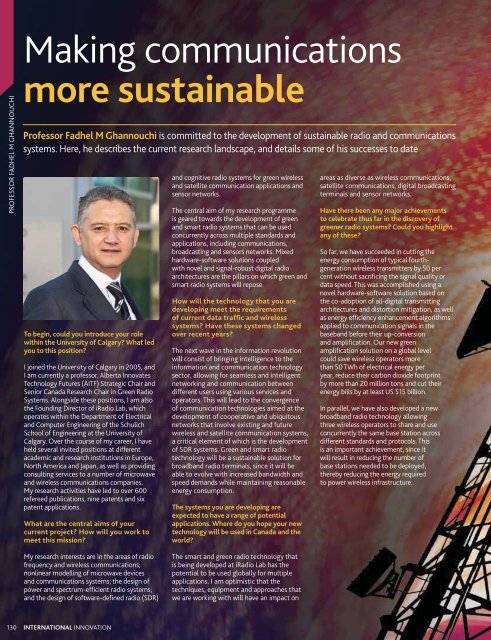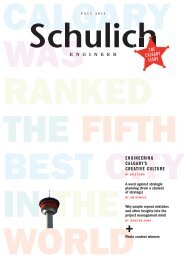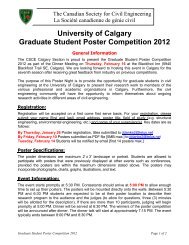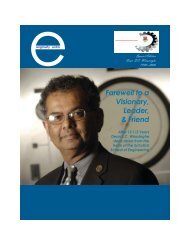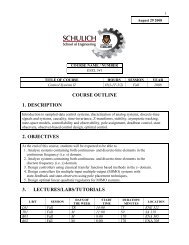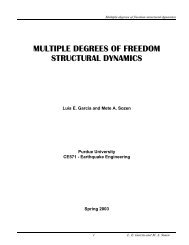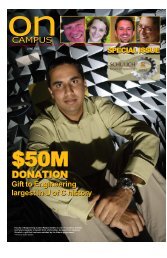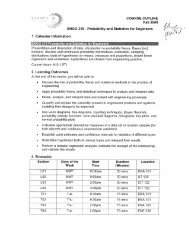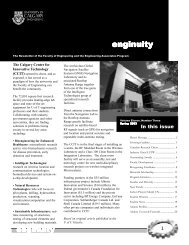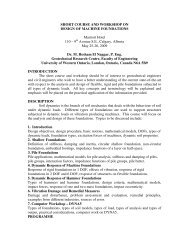Fadhel Ghannouchi - The Schulich School of Engineering ...
Fadhel Ghannouchi - The Schulich School of Engineering ...
Fadhel Ghannouchi - The Schulich School of Engineering ...
You also want an ePaper? Increase the reach of your titles
YUMPU automatically turns print PDFs into web optimized ePapers that Google loves.
PROFESSOR FADHEL M GHANNOUCHI<br />
Making communications<br />
more sustainable<br />
Pr<strong>of</strong>essor <strong>Fadhel</strong> M <strong>Ghannouchi</strong> is committed to the development <strong>of</strong> sustainable radio and communications<br />
systems. Here, he describes the current research landscape, and details some <strong>of</strong> his successes to date<br />
To begin, could you introduce your role<br />
within the University <strong>of</strong> Calgary What led<br />
you to this position<br />
I joined the University <strong>of</strong> Calgary in 2005, and<br />
I am currently a pr<strong>of</strong>essor, Alberta Innovates<br />
Technology Futures (AITF) Strategic Chair and<br />
Senior Canada Research Chair in Green Radio<br />
Systems. Alongside these positions, I am also<br />
the Founding Director <strong>of</strong> iRadio Lab, which<br />
operates within the Department <strong>of</strong> Electrical<br />
and Computer <strong>Engineering</strong> <strong>of</strong> the <strong>Schulich</strong><br />
<strong>School</strong> <strong>of</strong> <strong>Engineering</strong> at the University <strong>of</strong><br />
Calgary. Over the course <strong>of</strong> my career, I have<br />
held several invited positions at different<br />
academic and research institutions in Europe,<br />
North America and Japan, as well as providing<br />
consulting services to a number <strong>of</strong> microwave<br />
and wireless communications companies.<br />
My research activities have led to over 600<br />
refereed publications, nine patents and six<br />
patent applications.<br />
What are the central aims <strong>of</strong> your<br />
current project How will you work to<br />
meet this mission<br />
and cognitive radio systems for green wireless<br />
and satellite communication applications and<br />
sensor networks.<br />
<strong>The</strong> central aim <strong>of</strong> my research programme<br />
is geared towards the development <strong>of</strong> green<br />
and smart radio systems that can be used<br />
concurrently across multiple standards and<br />
applications, including communications,<br />
broadcasting and sensors networks. Mixed<br />
hardware-s<strong>of</strong>tware solutions coupled<br />
with novel and signal-robust digital radio<br />
architectures are the pillars on which green and<br />
smart radio systems will repose.<br />
How will the technology that you are<br />
developing meet the requirements<br />
<strong>of</strong> current data traffic and wireless<br />
systems Have these systems changed<br />
over recent years<br />
<strong>The</strong> next wave in the information revolution<br />
will consist <strong>of</strong> bringing intelligence to the<br />
information and communication technology<br />
sector, allowing for seamless and intelligent<br />
networking and communication between<br />
different users using various services and<br />
operators. This will lead to the convergence<br />
<strong>of</strong> communication technologies aimed at the<br />
development <strong>of</strong> cooperative and ubiquitous<br />
networks that involve existing and future<br />
wireless and satellite communication systems,<br />
a critical element <strong>of</strong> which is the development<br />
<strong>of</strong> SDR systems. Green and smart radio<br />
technology will be a sustainable solution for<br />
broadband radio terminals, since it will be<br />
able to evolve with increased bandwidth and<br />
speed demands while maintaining reasonable<br />
energy consumption.<br />
<strong>The</strong> systems you are developing are<br />
expected to have a range <strong>of</strong> potential<br />
applications. Where do you hope your new<br />
technology will be used in Canada and the<br />
world<br />
areas as diverse as wireless communications,<br />
satellite communications, digital broadcasting<br />
terminals and sensor networks.<br />
Have there been any major achievements<br />
to celebrate thus far in the discovery <strong>of</strong><br />
greener radio systems Could you highlight<br />
any <strong>of</strong> these<br />
So far, we have succeeded in cutting the<br />
energy consumption <strong>of</strong> typical fourthgeneration<br />
wireless transmitters by 50 per<br />
cent without sacrificing the signal quality or<br />
data speed. This was accomplished using a<br />
novel hardware-s<strong>of</strong>tware solution based on<br />
the co-adoption <strong>of</strong> all-digital transmitting<br />
architectures and distortion mitigation, as well<br />
as energy efficiency enhancement algorithms<br />
applied to communication signals in the<br />
baseband before their up-conversion<br />
and amplification. Our new green<br />
amplification solution on a global level<br />
could save wireless operators more<br />
than 50 TWh <strong>of</strong> electrical energy per<br />
year, reduce their carbon dioxide footprint<br />
by more than 20 million tons and cut their<br />
energy bills by at least US $15 billion.<br />
In parallel, we have also developed a new<br />
broadband radio technology allowing<br />
three wireless operators to share and use<br />
concurrently the same base station across<br />
different standards and protocols. This<br />
is an important achievement, since it<br />
will result in reducing the number <strong>of</strong><br />
base stations needed to be deployed,<br />
thereby reducing the energy required<br />
to power wireless infrastructure.<br />
My research interests are in the areas <strong>of</strong> radio<br />
frequency and wireless communications;<br />
nonlinear modelling <strong>of</strong> microwave devices<br />
and communications systems; the design <strong>of</strong><br />
power and spectrum-efficient radio systems;<br />
and the design <strong>of</strong> s<strong>of</strong>tware-defined radio (SDR)<br />
<strong>The</strong> smart and green radio technology that<br />
is being developed at iRadio Lab has the<br />
potential to be used globally for multiple<br />
applications. I am optimistic that the<br />
techniques, equipment and approaches that<br />
we are working with will have an impact on<br />
130 INTERNATIONAL INNOVATION
PROFESSOR FADHEL M GHANNOUCHI<br />
Redesigning base stations<br />
Given the rapid growth <strong>of</strong> communications networks, there is an urgent<br />
need for more sustainable technologies. Pioneering research at the<br />
University <strong>of</strong> Calgary, Canada, is making great strides towards this goal<br />
AS BUSINESSES, GOVERNMENTS,<br />
organisations and individuals across a diversity<br />
<strong>of</strong> fields become increasingly reliant on computer<br />
technology and growing levels <strong>of</strong> connectivity,<br />
data traffic and wireless applications continue<br />
to expand exponentially. <strong>The</strong> demand for everhigher<br />
networking and communicational capacity<br />
has necessitated a sharp increase in the number <strong>of</strong><br />
base stations and networks available, a trend which<br />
is accompanied by an array <strong>of</strong> safety, economic,<br />
environmental and logistical challenges.<br />
In response, ongoing studies at the University <strong>of</strong><br />
Calgary, Canada, are pursuing a holistic, end-toend<br />
comprehensive approach to devising novel,<br />
sustainable and energy-reducing technologies.<br />
<strong>The</strong> research is being led by Dr <strong>Fadhel</strong> M<br />
<strong>Ghannouchi</strong>, who is a Fellow <strong>of</strong> the Institute<br />
<strong>of</strong> Electrical and Electronics <strong>Engineering</strong> (IEEE),<br />
the Institute <strong>of</strong> <strong>Engineering</strong> and Technology<br />
(IET), the <strong>Engineering</strong> Institute <strong>of</strong> Canada (EIC),<br />
the Canadian Academy <strong>of</strong> <strong>Engineering</strong> (CAE)<br />
and the Royal Society <strong>of</strong> Canada (RSC), as well<br />
as holding the position <strong>of</strong> IEEE Distinguished<br />
Microwave Lecturer Emeritus. Working in close<br />
collaboration with his fellow researchers both at<br />
Calgary and elsewhere, <strong>Ghannouchi</strong> is optimistic<br />
that his groundbreaking approach to intelligent<br />
and green radio systems can have widespread<br />
social, environmental and economic benefits.<br />
THE CURRENT SITUATION<br />
<strong>The</strong>re are already over 5 million base stations<br />
in operation across the globe, a figure which<br />
is rising at a rate <strong>of</strong> between 10 and 15 per<br />
cent annually. As well as raising a number <strong>of</strong><br />
pressing issues on the grounds <strong>of</strong> sustainability<br />
and environmental impact, this is also causing a<br />
significant escalation in both the operating and<br />
capital costs <strong>of</strong> establishing and maintaining<br />
communications networks.<br />
<strong>The</strong> energy consumed by information and<br />
communication technology (ICT) infrastructure<br />
currently constitutes around 5 per cent <strong>of</strong> total<br />
global energy consumption, and there is widespread<br />
consensus that this will rise by as much as 20 per<br />
cent over the next three to four years. “Across the<br />
globe mobile networks alone currently consume<br />
approximately 120 terawatt hours <strong>of</strong> electricity per<br />
year, with between 50 and 70 per cent <strong>of</strong> this being<br />
consumed by the power amplifiers <strong>of</strong> base stations,<br />
and their related components,” <strong>Ghannouchi</strong><br />
explains. In Canada, there are over 30,000 such<br />
base stations, with each one consuming an average<br />
<strong>of</strong> 30 megawatt hours per year. This amounts to a<br />
total cost <strong>of</strong> over $100 million which, translated<br />
into carbon dioxide (CO 2<br />
) emissions, equates to<br />
around 1.5 million tons.<br />
In an attempt to curb these figures and to reduce<br />
both their operating costs and CO 2<br />
emissions,<br />
a large number <strong>of</strong> providers and operators <strong>of</strong><br />
wireless infrastructures have begun to invest<br />
in greener technologies. <strong>Ghannouchi</strong>, however,<br />
believes that more can be done, as he argues:<br />
“<strong>The</strong> reduction <strong>of</strong> power consumption in this<br />
area can be achieved more effectively by<br />
adopting a more holistic approach than the<br />
one these companies are pursuing”. To this end,<br />
his team is seeking an approach which crosses<br />
the seven different layers <strong>of</strong> the Open System<br />
Interconnection (OSI) model. <strong>The</strong>se layers<br />
range from the application layer’s processing<br />
algorithms to the physical layer’s front-end<br />
design for signalling and transmitting at radio<br />
frequency (RF), which comprises the power<br />
amplifier – the base station’s most energyconsuming<br />
component.<br />
A DUAL APPROACH<br />
In addition to his pr<strong>of</strong>essorship at the University<br />
<strong>of</strong> Calgary and his fellowships elsewhere,<br />
<strong>Ghannouchi</strong> is also the founding Director <strong>of</strong><br />
iRadio Lab at the University <strong>of</strong> Calgary, a position<br />
which gives him the perfect opportunity to<br />
promote this interconnected, comprehensive<br />
methodology. This, he believes, will be essential<br />
in developing a range <strong>of</strong> technologies which will<br />
improve the energy efficiency and effectiveness<br />
<strong>of</strong> base stations. In addition, he and his<br />
colleagues are also working on a novel hybrid<br />
power grid which puts a greater emphasis on<br />
renewable energy, and which can be combined<br />
with existing base station technologies. <strong>The</strong><br />
researchers at iRadio Lab are optimistic that their<br />
approach will have the dual impact <strong>of</strong> not only<br />
reducing the amount <strong>of</strong> energy being consumed<br />
by communications infrastructure , but also<br />
making the energy which is being consumed<br />
greener. Consequently, it is estimated that the<br />
results <strong>of</strong> <strong>Ghannouchi</strong> research could lead to a<br />
reduction in the energy consumed by Canada’s<br />
communications network by 50 per cent, saving<br />
Canadian organisations over $100 million and<br />
750,000 tons <strong>of</strong> CO 2<br />
emissions per year.<br />
NETWORK OPTIMISATION AND RESOURCE<br />
MANAGEMENT<br />
<strong>The</strong> first task for <strong>Ghannouchi</strong> and his colleagues<br />
at GreenCom is the ongoing investigation<br />
WWW.RESEARCHMEDIA.EU 131
PROFESSOR FADHEL M GHANNOUCHI<br />
into network architectures, and how the<br />
management <strong>of</strong> resources within them can be<br />
optimised in order to minimise the amount <strong>of</strong><br />
power required to transmit each bit between<br />
users. <strong>The</strong>se enquiries operate at a network<br />
level, and involve finding methods <strong>of</strong> adopting<br />
a smart power-grid in order to increase endto-end<br />
reliability, flexibility, security and<br />
quality. Building on existing studies in this field,<br />
<strong>Ghannouchi</strong> proposes to consider network<br />
topology in greater detail, and the role it plays<br />
in enabling broadband networks to achieve their<br />
anticipated performance level.<br />
Traditional approaches to this area have<br />
involved moving from macrocell environments<br />
to smaller femtocell scenarios. <strong>The</strong> drawbacks<br />
<strong>of</strong> this, however, include rendering inefficient<br />
conventional network management techniques<br />
and protocols, and the creation <strong>of</strong> new problems<br />
surrounding resource allocation, network<br />
layout and the optimisation <strong>of</strong> protocols.<br />
This necessitates a shift towards cooperative<br />
networks and the incorporation <strong>of</strong> novel physical<br />
layer processing and radio head architectures<br />
into the network.<br />
In anticipation <strong>of</strong> these issues, <strong>Ghannouchi</strong> and<br />
his colleagues are working on strategies which<br />
will assist in the development <strong>of</strong> cooperative<br />
and cognitive network architectures, which are<br />
expected to improve the allocation <strong>of</strong> resources<br />
in order to reduce the amount <strong>of</strong> energy<br />
required to transport each bit, without having<br />
a negative impact on the quality <strong>of</strong> service.<br />
This study will be executed using a cross-layer<br />
approach, considering all interactions between<br />
the various OSI layers in order to devise a<br />
comprehensive solution.<br />
SIGNAL PROCESSING FOR GREEN RADIOS<br />
A further key aspect <strong>of</strong> <strong>Ghannouchi</strong>’s work<br />
is his studies into how energy consumption<br />
in base stations, mobile stations and relay<br />
infrastructure can be reduced through improving<br />
signal processing algorithms by conditioning the<br />
signal and/or control RF front-end and network<br />
infrastructure. Often, interference and hardware<br />
impairments caused by stressful communication<br />
signals with high dynamic range and wide<br />
bandwidth occur as a result <strong>of</strong> multiuser access,<br />
reconfigurability and infrastructure sharing <strong>of</strong><br />
radio channels. This can have a negative effect<br />
on the overall power efficiency <strong>of</strong> the radio.<br />
For green radio systems and networks to replace<br />
these conventional systems, there is a need to<br />
develop signal processing algorithms which can<br />
preprocess and condition communication signals<br />
for improved linearisation and energy efficiency.<br />
This in turn calls for a co-design approach to RF<br />
and digital signal processing in order to maintain<br />
reconfigurability and agility between the two<br />
ends <strong>of</strong> the communication link.<br />
As part <strong>of</strong> their ongoing studies, <strong>Ghannouchi</strong><br />
and his collaborators are conducting extensive<br />
investigations into efficient transmission<br />
<strong>Ghannouchi</strong> and his collaborators are also heavily involved in developing<br />
ways for communications networks to run on energy from more<br />
sustainable, greener sources<br />
technologies and coding techniques, with<br />
their findings anticipated to form the basis<br />
<strong>of</strong> novel solutions that further reduce energy<br />
consumption in terminals.<br />
SOFTWARE-DEFINED RADIO SYSTEMS<br />
<strong>Ghannouchi</strong> is also assessing the potential <strong>of</strong><br />
intelligent s<strong>of</strong>tware-defined radio (SDR) and<br />
cognitive radio (CR) systems to further shrink<br />
the CO 2<br />
footprint <strong>of</strong> communications networks.<br />
Transmitting and receiving <strong>of</strong> communications<br />
via radio frequencies relies on a transceiver, a<br />
central unit responsible for both the sending and<br />
receiving data. As part <strong>of</strong> his studies, <strong>Ghannouchi</strong><br />
is working to develop SDR transceiver which is<br />
capable <strong>of</strong> running on different standards and<br />
frequencies concurrently. Such a system would<br />
have the ability to monitor its electromagnetic<br />
environment with relation to spectrum and<br />
power, opening up the possibility for transceivers<br />
to assess radio activity in their vicinity in real<br />
time and transmit signals on a selected and less<br />
crowded spectrum, and with the appropriate<br />
power level. “This would result in technology<br />
which makes better use <strong>of</strong> resources – both<br />
power and bandwidth – and, at the same time,<br />
minimises the interference between users,”<br />
<strong>Ghannouchi</strong> enthuses.<br />
INTRODUCING RENEWABLE ENERGY<br />
Finally, in addition to their substantial body <strong>of</strong><br />
work focused on making technologies more<br />
efficient, <strong>Ghannouchi</strong> and his collaborators are<br />
also heavily involved in developing ways for<br />
communications networks to run on energy<br />
from more sustainable, greener sources. Whilst<br />
previous studies have made attempts to use<br />
renewable energy to power medium- and lowpower<br />
base stations, such efforts were focused<br />
on very specific, localised installations, and were<br />
not coupled with attempts to reduce base station<br />
energy consumption, making them unworkable<br />
on a network level.<br />
<strong>Ghannouchi</strong> believes that a more comprehensive,<br />
thorough method is needed in order to make best<br />
use <strong>of</strong> incorporating renewable technologies into<br />
communication networks. This approach also<br />
improves the longevity <strong>of</strong> base stations through<br />
better consideration <strong>of</strong> the balance between<br />
the availability <strong>of</strong> the energy source and the<br />
performance and integrity <strong>of</strong> the network. In this<br />
endeavour, the researchers will consider a wide<br />
variety <strong>of</strong> renewable energies, from harvested<br />
forms such as wind and solar power to recycled<br />
varieties such as electromagnetic radiation and<br />
thermal dissipation. <strong>The</strong> coordination <strong>of</strong> power<br />
usage in hybrid power micro-grids will also be<br />
examined by the researchers, leading them<br />
to consider small-scale photovoltaic panels,<br />
wind turbines and battery storage as potential<br />
sources <strong>of</strong> renewable energy, in conjunction with<br />
traditional fossil fuel approaches. <strong>Ghannouchi</strong><br />
and his colleagues are confident that their work<br />
in this area will result in a greater understanding<br />
<strong>of</strong> the interface between more efficient radio<br />
infrastructures and greener, more sustainable<br />
hybrid power grids.<br />
IRADIO LAB AND BEYOND<br />
In parallel to his other work, in 2005 <strong>Ghannouchi</strong><br />
established iRadio Lab, which has received<br />
funding both at governmental and university<br />
level. One <strong>of</strong> three university spin-<strong>of</strong>f companies<br />
which <strong>Ghannouchi</strong> has been involved in c<strong>of</strong>ounding,<br />
iRadio Lab aims to develop new<br />
knowledge and novel enabling technologies<br />
which have a relevance to the intelligent and<br />
green radio systems which he is committed to<br />
enhancing. This is being achieved by targeting<br />
the future generations <strong>of</strong> wireless and satellite<br />
communications which will cover the RF to<br />
millimetre-wave bands. This work provides<br />
<strong>Ghannouchi</strong> with a valuable opportunity to<br />
develop practical knowledge in conjunction<br />
with partners and sponsors within the industry.<br />
It also ensures that the lab’s work is as relevant<br />
as possible, finding practical and workable<br />
solutions to real world problems.<br />
<strong>Ghannouchi</strong> also considers harnessing the<br />
potential <strong>of</strong> students as a crucial part <strong>of</strong> his<br />
work: “iRadio Lab’s mandate is also to train<br />
highly qualified personnel in nanoelectronics,<br />
wireless sensor networks and wireless<br />
and satellite communications science and<br />
technology,” notes <strong>Ghannouchi</strong>. Over the<br />
course <strong>of</strong> his career he has been responsible for<br />
graduating more than 100 Master’s, PhD and<br />
PDF students, either as a lecturer or personal<br />
mentor. Having been guided by <strong>Ghannouchi</strong>, an<br />
international leader in his field, these students<br />
have been provided with a strong platform<br />
from which to become the next generation <strong>of</strong><br />
communications researchers.<br />
Through a combination <strong>of</strong> excellent teaching<br />
and world-class research <strong>Ghannouchi</strong> and his<br />
colleagues are not only making great practical<br />
and theoretical strides in their attempt to<br />
minimise the environmental and economic<br />
impact <strong>of</strong> communications networks, but also<br />
in laying the foundations for this work to be<br />
continued by future generations. <strong>The</strong>re is much<br />
cause for optimism that their research can<br />
succeed in developing the technologies required<br />
and can result in significant social benefits.<br />
132 INTERNATIONAL INNOVATION
INTELLIGENCE<br />
INTELLIGENT AND GREEN<br />
RADIO SYSTEMS<br />
OBJECTIVES<br />
• To develop innovative digitally enhanced and<br />
all-digital radio systems for the next generation<br />
<strong>of</strong> broadband green radio systems<br />
• To design and develop innovative energyefficient<br />
and environmentally friendly<br />
transceivers for broadband wireless, satellite,<br />
sensing and broadcasting applications<br />
KEY COLLABORATORS<br />
Dr M Helaoui, PhD, Assistant Pr<strong>of</strong>essor at<br />
University <strong>of</strong> Calgary • Dr M Fattouche,<br />
Pr<strong>of</strong>essor University <strong>of</strong> Calgary • Dr K Rawat,<br />
Indian Institute <strong>of</strong> technology, Delhi, India • Dr<br />
R Negra, Aachen RWTH University, Aachen,<br />
Germany • Dr M S Hashmi, Indraprastha<br />
Institute <strong>of</strong> Information Technology, Delhi, India<br />
• Dr W Chen, Tsinghua University, Beijing China<br />
• Dr T Liu, Ningbo University, China • Dr S-C<br />
Jung, SungKyunKwan University, South Korea •<br />
Dr A S Bassam, QUALCOMM, San Diego, USA<br />
• Dr S Bensmida, Bristol University, Bristol, UK<br />
• Dr A Mohammadi, Amirkabir University <strong>of</strong><br />
Technology, Tehran, Iran • Dr D Wang, New<br />
York Institute <strong>of</strong> Technology (NYIT), Nanjing,<br />
China • Dr O Hammi, King Fahd University<br />
<strong>of</strong> Pertolum and Minerals, Kingdom <strong>of</strong> Saudi<br />
Arabia • Dr A B Kouki, Ecole de Technologie<br />
Supérieure, Montreal, University du Quebec,<br />
Canada • Dr F Falcone, Public University <strong>of</strong><br />
Navarra, Spain • Dr S Tatu, Institut de recherche<br />
Scientifique du Quebec, Montreal • Dr C Akyel,<br />
Ecole Polytechnqiue de Montreal, Canada • Dr<br />
A Gharsallah, University <strong>of</strong> Manar, Tunisia • Dr<br />
Ghazel, University <strong>of</strong> Carthage, Tunisia<br />
MAIN INDUSTRIAL PARTNERS<br />
Ericson Canada • Agilent Technologies •<br />
Focus Microwaves • Canada Microelectronics<br />
Corporation • Altera Corporation • Xilinx<br />
Corporation • Canadian Space Agency<br />
MAIN FUNDING SOURCES<br />
Alberta Innovates Technology Futures,<br />
Strategic Chair program: Chair in Intelligent<br />
Radio Technology. • Canada Research Chair<br />
Program: Chair in Green Radio Systems • Canada<br />
Foundation <strong>of</strong> Innovation • Alberta Enterprise<br />
and Advanced Education • University <strong>of</strong> Calgary<br />
CONTACT<br />
Dr <strong>Fadhel</strong> M <strong>Ghannouchi</strong><br />
Principal Investigator<br />
Department <strong>of</strong> Electrical and Computer<br />
<strong>Engineering</strong><br />
<strong>Schulich</strong> <strong>School</strong> <strong>of</strong> <strong>Engineering</strong><br />
<strong>The</strong> University <strong>of</strong> Calgary<br />
ICT 336, 2500 University Drive NW<br />
Calgary, Alberta T2N 1N4, Canada<br />
T +1 403 220 5807<br />
E fadhel ghannouchi@ucalgary.ca<br />
www.iradio.ucalgary.ca<br />
FADHEL M GHANNOUCHI is Pr<strong>of</strong>essor in<br />
the Department <strong>of</strong> Electrical and Computer<br />
<strong>Engineering</strong> <strong>of</strong> the <strong>Schulich</strong> <strong>School</strong> <strong>of</strong><br />
<strong>Engineering</strong> at the University <strong>of</strong> Calgary and is<br />
the founding Director <strong>of</strong> iRadio Lab. He is also<br />
WWW.RESEARCHMEDIA.EU 133


